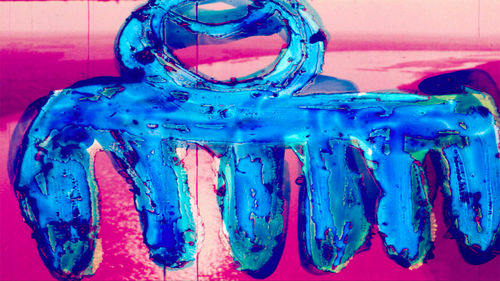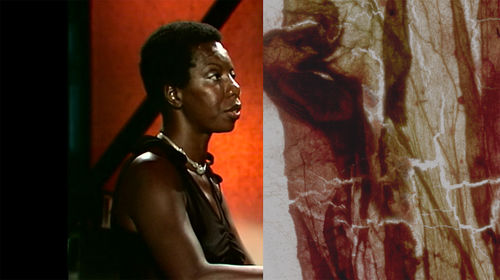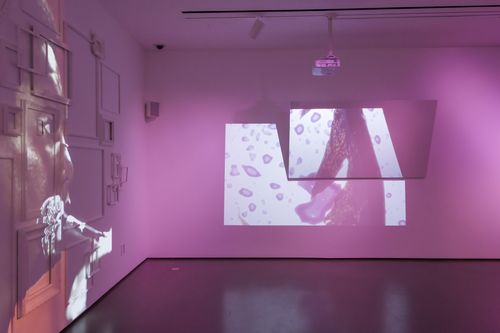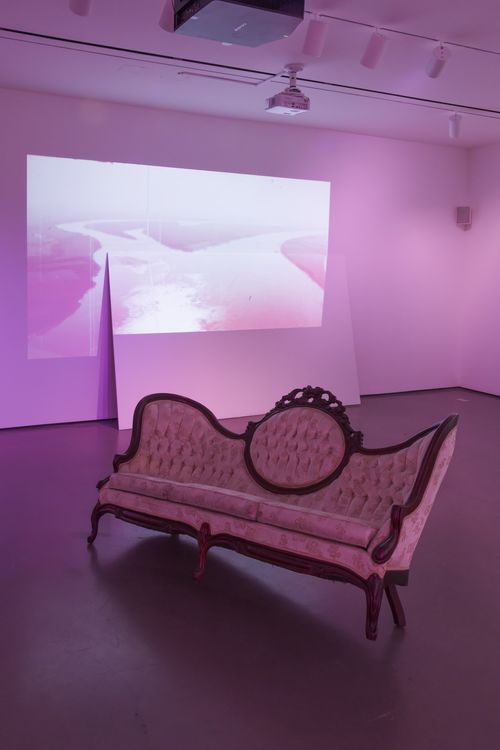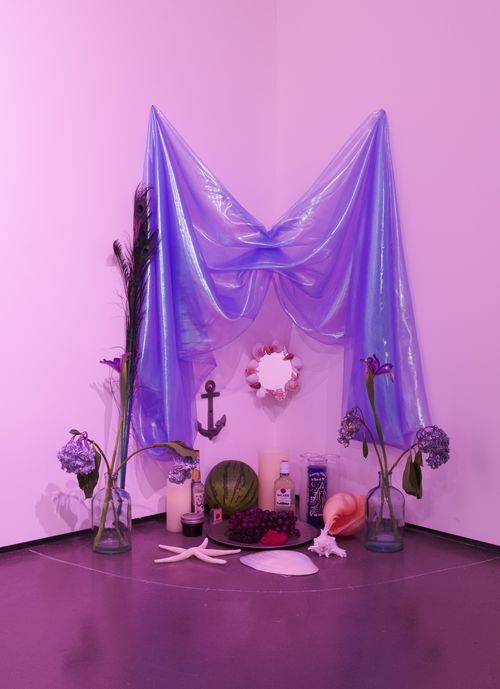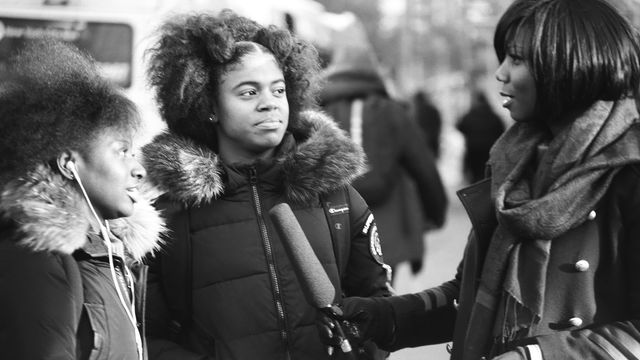
Hammer Projects: Ja'Tovia Gary
- – This is a past exhibition
Filmed on location in Harlem, New York, and in Claude Monet’s historic gardens in Giverny, France, THE GIVERNY SUITE is a multi-textured cinematic poem that meditates on the safety and bodily autonomy of Black women. Ja’Tovia Gary (b. 1984, Dallas) unleashes an arsenal of techniques and materials, including direct animation on archival 16mm film, woman-on-the-street interviews, and montage editing, to explore the creative virtuosity of Black femme performance figures while interrogating the histories of those bodies as spaces of forced labor and commodified production.
Hammer Projects: Ja’Tovia Gary is organized by Erin Christovale, associate curator, with Vanessa Arizmendi, curatorial assistant.
Essay
Artist and filmmaker Ja’Tovia Gary (b. 1984, Dallas) creates documentary film and experimental video works that weave together various forms of media and footage in order to provide a more liberated and expansive view of contemporary Black life.
Filmed on location in the gardens of Claude Monet’s home in Giverny, France, and on the streets of Harlem, New York, THE GIVERNY SUITE (2019) is a three-channel cinematic tapestry that considers the bodily autonomy and performance-based labor of Black women. The installation uses a variety of techniques and materials, including direct animation on archival 16mm film, woman-on-the-street interviews, and montage editing, to further delve into Black feminist theory and to interrogate the nuanced ways in which survival is employed.
Rooting herself in a tradition of Black femme performativity, Gary is seen performing in each location. The Giverny segment is movement based, with a focus on the artist’s physicality as it both relates to and contends with the natural surroundings. Through various poses, she becomes her own muse, at times positioning her body to mimic classic images of the Western female nude. Gary’s appearance, however, challenges the Eurocentric painterly tradition of such depictions, which she toys with by taking up space in the garden—stretching out her body and pacing around in her bare feet, eventually belting out a rage-filled scream. In Harlem, Gary’s performativity is housed in her voice as she conducts interviews on the street.
Donning a wig, she stands on the corner of West 116th Street and Malcolm X Boulevard calling out to Black women of all ages and backgrounds to ask them a simple but loaded question: Do you feel safe? Their answers vary but the question looms throughout THE GIVERNY SUITE as a larger understanding that Black women are hardly ever guaranteed safety and that it is often met with a negotiation that compromises other aspects of their lives. By pairing these opposing spaces—the pristine, manicured French garden and the tireless, bustling American city—Gary not only accentuates the range of her performance but also highlights how each environment responds to her blackness, reinforcing deeply rooted cultural and social constructs.
THE GIVERNY SUITE also incorporates a range of found and archival footage, including a performance by Nina Simone at the 1976 Montreux Jazz Festival and excerpts from the film Zouzou (1934), starring Josephine Baker. Simone’s emotional rendering of Morris Albert’s love song “Feelings” proves to be one of the most raw and intimate documents of her virtuosity to date. She commands the stage, asserting her authority as she performs for a mostly European audience, pausing during her set to blurt out musings and reflections, eventually exhorting the festival goers to clap. She refers to herself as a robot and after singing the lyrics “teardrops falling down my face, trying to forget all my feelings of love,” exclaims, “What a shame to have to write a song like that!” It is clear through Simone’s frenzied stream of consciousness that the lyrics resound deeply for her, begging the larger question of who is considered deserving of love and affection. Simone’s personal life was marked by several failed relationships, including her contentious marriage to her long-term manager Andy Stroud, a former police officer. As she rose to celebrity, she was often confronted by the clash between her appearance as a dark-skinned, full-bodied Black woman and Westernized standards of beauty and physical manifestations of success. Gary interjects this footage of Simone throughout the suite as a call to action, pointing to a lack of love and care that so often befalls Black women in relationship to their everyday labor and contributions to cultural production.
Baker, who renounced her US citizenship and moved to France in the 1920s, was the first Black woman to star in a major feature film—Siren of the Tropics (1927). She was also an avid supporter of the civil rights movement and a French Resistance agent. In Zouzou, Baker plays a young laundress who decides to take a stab at performing onstage in order to make bail for her longtime love interest, a Frenchman named Jean, after he is thrown in jail and accused of murder. Baker’s performance exemplifies her renowned singing and dancing skills, but for the majority of her time on stage she is trapped in an oversized birdcage. After Zouzou bails out Jean, he runs off with another woman, and even though her stage career takes off, she is forever chasing after his affection. As with Simone, matters of love are at stake. Both of these women, though brilliant and virtuosic, are neglected romantically.
Centered in the middle of the gallery is a leaning settee, whose offset disposition falls in line with the spatial vertigo of the installation. The settee, a European invention of the late seventeenth century, functions in THE GIVERNY SUITE as a stand-in for colonial power, and, in an act of rebellion, Gary has severed it at the leg. It faces off against two altars in either corner of the space dedicated to the African goddesses Oshun and Yemaya, whose maternal and sacred energies wash over the suite. Oshun is a river deity who is often depicted in bright yellow and represents divine femininity, love, and fertility. Yemaya, whose colors are white and royal blue, is known to be a fierce protector of women, often depicted as a mermaid that responds to the oceans and the moon. Both goddesses originate from the Yoruban spirituality Ifá, which was carried over to the Americas through the transatlantic slave trade.
Formally, in THE GIVERNY SUITE Gary brings forth several techniques and traditions that underscore the experimental origins of cinema and the social movements that have shaped its trajectory. Her questions on the street in Harlem reference 1960s French cinema verité, in which the filmmaker is often seen participating in front of the camera and engaging with everyday people, which, at the time, challenged dominant documentary conventions. She also employs methods of altering the film stock itself. For example, she incorporates direct animation onto 16mm found footage of the Mississippi River and Niagara Falls, washing the celluloid with neon pinks and reds and scratching imagery such as West African adinkra symbols, stars, fish, and diamonds directly onto the stock. Her use of the varying symbols alludes to a loaded history of these seemingly disparate bodies of water that both flow directly into the Atlantic Ocean. The Mississippi River, which meets the Atlantic at the Gulf of Mexico, was a key economic thoroughfare in the trafficking of enslaved African people who were bought and sold in America; the Niagara River, which provides the hydropower for the Falls, was known to be one of the final destinations on the Underground Railroad before crossing into Canada. Gary also at times adheres organic material such as leaves and flower petals from the garden in Giverny directly onto the film stock, a process made popular by Stan Brakhage in his silent 1963 short film Mothlight. Gary uses the organic matter’s poetic presence structurally to break up certain moments, allowing for a visual release of abstract colors and shapes that serve as a patterned ambience, providing bursts of visual vibrancy amid the complex subject matter.
—Erin Christovale



